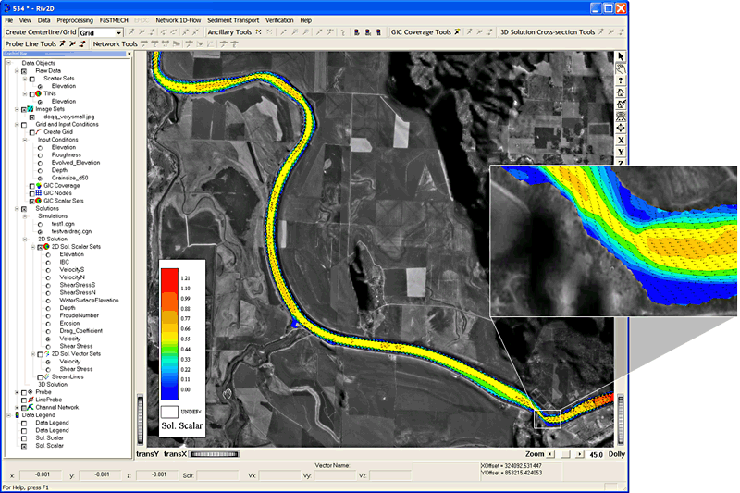Multidimensional Surface-Water Modeling System
The U.S. Geological Survey’s (USGS) Multi-Dimensional Surface-Water Modeling System (MD_SWMS) is a pre- and post-processing application for computational models of surface-water hydraulics. The system is both a tool and framework that provides an easy to use interface to a variety of environmental hydraulic models.
The tool is a Graphical User Interface (GUI) (McDonald and others, 2005) that allows the modeler to build and edit data sets of the modeling system’s computational surface-water models. The framework links the GUI tool with the modeling applications. New applications can be adapted to the framework through modification of the input and output software routines. In this way, MD_SWMS is flexible and generic, easily incorporating new models and avoiding the necessity of writing a new GUI for each modeling application.

Figure 1. The MD_SWMS GUI tool shown with an application of the Kootenai
River, Idaho. The GUI features menus, toolbars, treeview of data objects loaded
into the project, graphics view with tools for zooming and panning, status bar
and probe bar for dynamic feedback of data values. The main panel of the
application shows a portion of a 10-kilometer reach of the Kootenai River with a
model prediction of velocity overlain on a georeferenced digital orthoquad. A
detail (inset) of the solution shows the complicated flow pattern in a sharp
bend of the river. Velocity magnitude is shown by color and velocity vectors are
shown in black. (Click on image to enlarge)
The GUI tool is a sophisticated 1, 2, and 3-dimensional interactive GUI (fig. 1) that is used to build and visualize all aspects of computational surface-water applications. Surface-water modeling is a process whereby the modeler builds the grid, applies boundary conditions, runs the simulation, and evaluates the results. The MD_SWMS GUI tool facilitates this process by providing an easy way to apply this process iteratively until a useful result has been obtained.
The Computational Fluid Dynamics General Notation System (CGNS) is used to provide the framework for incorporating surface-water models into MD_SWMS. CGNS is a database developed to assist the exchange of data between aerodynamic Computational Fluid Dynamic (CFD) applications and it consists of two parts: (1) a standard format for recording the data, and (2) a software interface that reads, writes, and modifies data in that format (Legensky and others, 2002; http://www.cgns.org). CGNS provides a bridge between MD_SWMS and its environmental surface-water applications in the following ways:
- All data designed in the MD_SWMS GUI tool is written to a CGNS database including descriptions of the computational grid, boundary conditions, initial conditions, and application specific parameters.
- Modeling applications in MD_SWMS read from the CGNS database to initialize and run the model after which the model solution is appended to the database.
- The model solution is then read by MD_SWMS for visualization, analysis, and verification.
The CGNS framework is used to separate the GUI from the computational models, which allows MD_SWMS to be a single tool that can be used with many applications.
References
Legensky, S.M., Edwards, D.E., Bush, R.H., Poirier, D.M.A., Rumsey, C.L., Cosner, R.R., and Towne, C.E., 2002, CFD General Notation System (CGNS)—Status and future directions: American Institute of Aeronautics and Astronautics Paper 2002-0752.
McDonald, R.R., Nelson, J.M., and Bennett, J.P., in press, Multi-dimensional surface-water modeling system user’s guide: U.S. Geological Survey Techniques and Methods, 6-B2, 136 p.
MDSWMS Pages
Downloads: For current software downloads users are directed to visit the International River Interface Cooperative website: http://i-ric.org/en/downloads.htm. To download legacy files please contact Rich McDonald.
